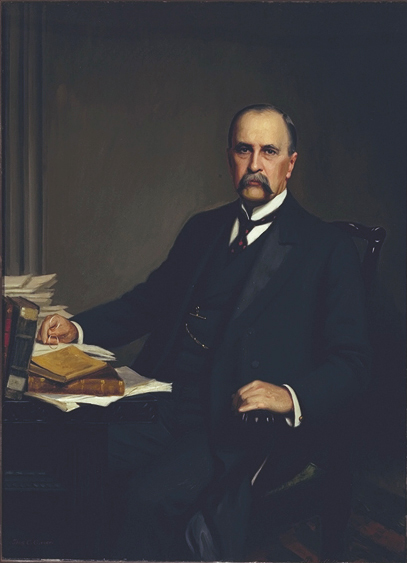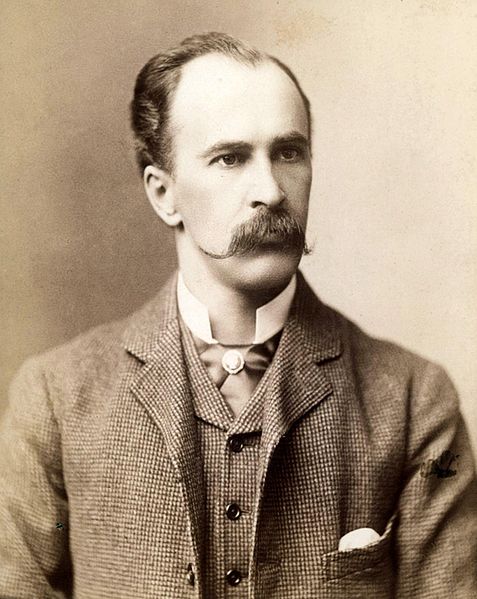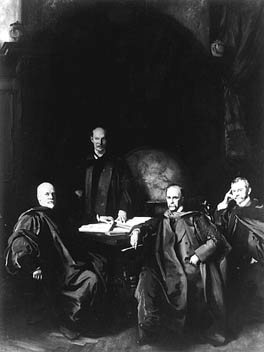<Back to Index>
- Physician William Osler, 1849
- Writer and Artist Bruno Schulz, 1892
- 6th Shogun of the Ashikaga Shogunate Ashikaga Yoshinori, 1394
PAGE SPONSOR



Sir William Osler, 1st Baronet (July 12, 1849 – December 29, 1919) was a Canadian physician. (pronounced "oh-sler") He was one of the "Big Four" founding professors at Johns Hopkins Hospital as the first Professor of Medicine and founder of the Medical Service there. (The "Big Four" were William Osler, Professor of Medicine; William Stewart Halsted, Professor of Surgery; Howard A. Kelly, Professor of Gynecology; and William H. Welch, Professor of Pathology.) Osler created the first residency program for specialty training of physicians, and he was the first to bring medical students out of the lecture hall for bedside clinical training.
He has been called the "Father of modern medicine." Osler was a pathologist, physician, educator, bibliophile, historian, author, and renowned practical joker.
William's great grandfather, Edward Osler, was variously described as either a merchant seaman or a pirate, and one of William's uncles (Edward Osler 1798 - 1863), a medical officer in the Navy, wrote the Life of Lord Exmouth and the poem The Voyage. William Osler's father, Featherstone Lake Osler (1805 – 1895), the son of a shipowner at Falmouth, Cornwall, was a former Lieutenant in the Royal Navy and served on H.M.S. Victory. In 1831 Featherstone Osler was invited to serve on H.M.S. Beagle as the science officer on Charles Darwin's historic voyage to the Galápagos Islands,
but he turned it down as his father was dying. As a teenager
Featherstone Osler was aboard H.M.S. Sappho when it was nearly
destroyed by Atlantic storms and left adrift for weeks. Serving in the
Navy he was ship - wrecked off Barbados. In 1837 Featherstone Osler retired from the Navy and emigrated to Canada, becoming a 'saddle - bag minister' in rural Upper Canada.
When Featherstone Osler and his bride (Ellen Free Picton) arrived in
Canada they were nearly ship - wrecked again on Egg Island in the Gulf of Saint Lawrence. The Oslers had several children and William was the brother of Britton Bath Osler and Sir Edmund Boyd Osler. William Osler was born in Bond Head, Canada West (now Ontario) on July 12, 1849, and raised after 1857 in Dundas, Ontario. (He was called William after William of Orange, who won the Battle of the Boyne on July 12, 1690.) Educated at the original Trinity College School in Weston Ontario, as a teenager William Osler's aim was to follow his father into the Anglican ministry and to that end he entered Trinity College, Toronto (now a constituent college of the University of Toronto)
in the autumn of 1867. However, his chief interest proved to be
medicine and, forsaking his original intention, he enrolled in the
Toronto School of Medicine. This was a proprietary, or privately owned
institution, not to be confused with the Medical Faculty of the University of Toronto, which was then not active as a teaching body. Osler left the Toronto School of Medicine after being accepted to the MDCM program at McGill University Faculty of Medicine in Montreal. He received his medical degree (MDCM) in 1872. Following post - graduate training in Europe, Osler returned to McGill University Faculty of Medicine as a professor in 1874. It is here that he created the first formalized journal club. In 1884, he was appointed Chair of Clinical Medicine at the University of Pennsylvania in Philadelphia and in 1885, was one of the seven founding members of the Association of American Physicians,
a society dedicated to "the advancement of scientific and practical
medicine." When he left Philadelphia in 1889, his farewell address Aequanimitas was on the equanimity necessary for physicians. In 1889, he accepted the position as the first Physician - in - Chief of the new Johns Hopkins Hospital in Baltimore, Maryland, USA. Shortly afterwards, in 1893, Osler was instrumental in the creation of the Johns Hopkins University School of Medicine and
became one of the school's first professors in medicine. Osler quickly
increased his reputation as a clinician, humanitarian and teacher. He
presided over a rapidly expanding domain. In the Hospital's first year
of operation, when it had 220 beds, 788 patients were seen for a total
of over 15,000 days of treatment. Sixteen years later, when Osler
left for Oxford, over 4,200 patients were seen for a total of nearly
110,000 days of treatment. In 1905, he was appointed to the Regius Chair of Medicine at Oxford, which he held until his death. He was also a Fellow of Christ Church, Oxford. In 1911, he initiated the Postgraduate Medical Association, of which he was the first President. Osler was created a baronet in the Coronation Honours List of 1911 for his many contributions to the field of medicine. Perhaps
Osler's greatest contribution to medicine was to insist that students
learn from seeing and talking to patients and the establishment of the medical residency.
This latter idea spread across the English speaking world and remains
in place today in most teaching hospitals. Through this system, doctors
in training make up much of a hospital's medical staff. The success of
his residency system depended, in large part, on its pyramidal
structure with many interns, fewer assistant residents and a single
chief resident, who originally occupied that position for years. While
at Hopkins Osler established the full time, sleep - in residency system
whereby staff physicians lived in the Administration Building of the
Hospital. As established, the residency was open ended, and long tenure
was the rule. Doctors spent as long as seven or eight years as
residents, during which time they led a restricted, almost monastic
life. He
liked to say, "He who studies medicine without books sails an uncharted
sea, but he who studies medicine without patients does not go to sea at
all." His best known saying was "Listen to your patient, he is telling
you the diagnosis," which emphasises the importance of taking a good
history. The
contribution to medical education of which he was proudest was his idea
of clinical clerkship — having third and fourth year students work
with patients on the wards. He pioneered the practice of bedside
teaching making rounds with a handful of students, demonstrating what
one student referred to as his method of "incomparably thorough
physical examination." Soon after arriving in Baltimore Osler insisted
that his medical students attend at bedside early in their training: by
their third year they were taking patient histories, performing
physicals and doing lab tests examining secretions, blood and excreta. He reduced the role of didactic lectures
and once said he hoped his tombstone would say only, "He brought
medical students into the wards for bedside teaching." He also said, "I
desire no other epitaph … than the statement that I taught medical
students in the wards, as I regard this as by far the most useful and
important work I have been called upon to do." Osler fundamentally
changed medical teaching in the North America, and this influence,
helped by a few such as the Dutch internist Dr. P.K. Pel, spread to medical schools across the globe. Osler was a prolific author and a great collector of books and other material relevant to the history of medicine. He willed his library to the Faculty of Medicine of McGill University where it now forms the nucleus of McGill University's Osler Library of the History of Medicine, which opened in 1929. The printed and extensively annotated catalogue of this donation is entitled "Bibliotheca Osleriana: a catalogue of books illustrating the history of medicine
and science, collected, arranged and annotated by Sir William Osler,
Bt. and bequeathed to McGill University". Osler
was a strong supporter of libraries and served on the library
committees at most of the universities at which he taught and was a
member of the Board of Curators of the Bodleian Library in Oxford. He was instrumental in founding the Medical Library Association in
North America and served as its second President from 1901 - 1904. In
Britain he was the first (and only) President of the Medical Library
Association of Great Britain and Ireland and also a President of the Bibliographical Society of London (1913). Osler
was a prolific author and public speaker and his public speaking and
writing were both done in a clear, lucid style. His most famous work, 'The Principles and Practice of Medicine' quickly
became a key text to students and clinicians alike. It continued to be
published in many editions until 2001 and was translated into many
languages. (See Osler Library Studies in the History of Medicine vol.
8.) It is notable in part for supporting the use of Bloodletting as recently as 1923. Though his own textbook was a major influence in medicine for many years, Osler described Avicenna as the 'author of the most famous medical textbook ever written.' He noted that Avicenna's Canon of Medicine remained 'a medical bible for a longer time than any other work. Osler's essays were important guides to physicians. The title of his most famous essay, Aequanimitas,
espousing the importance of imperturbability, is the motto on the Osler
family crest and is used on the Osler housestaff tie and scarf at
Hopkins.
Osler
is well known in the field of gerontology for the speech he gave when
leaving Hopkins to become the Regius Professor of Medicine at Oxford.
His speech "The Fixed Period", given on 22 February 1905, included some
controversial words about old age. Osler, who had a well developed
humorous side to his character, was in his mid fifties when he gave the
speech and in it he mentioned Anthony Trollope's The Fixed Period (1882),
which envisaged a College where men retired at 67 and after a
contemplative period of a year were 'peacefully extinguished' by
chloroform. He claimed that, "the effective, moving, vitalizing work of
the world is done between the ages of twenty - five and forty" and it
was
downhill from then on. Osler's speech was covered by the popular press
which headlined their reports with "Osler recommends chloroform at
sixty". The Fixed Period speech is included in the book of his
collected addresses, "Aequanimitas, with other Addresses to Medical Students etc.") An
inveterate prankster, he wrote several humorous pieces under the
pseudonym "Egerton Yorrick Davis", even fooling the editors of the Philadelphia Medical News into publishing a report on the imaginary phenomenon of penis captivus, on December 13, 1884. The letter (still cited in all seriousness in a number of textbooks) was apparently a response to a report on the phenomenon of vaginismus reported three weeks previously in the Philadelphia Medical News by Osler’s colleague Theophilus Parvin. Davis, a prolific writer of letters to medical societies, purported to be a retired US Army surgeon living in Caughnawaga, Quebec (now called Kahnawake), author of a controversial paper on the obstetrical habits of Native American tribes which was suppressed and unpublished. Osler would enhance Davis' myth by signing Davis' name to hotel registers and medical conference attendance lists; Davis was eventually reported drowned in the Lachine Rapids in 1884. Throughout his life, Osler was a great admirer of the 17th century physician and philosopher Sir Thomas Browne. He died at the age of 70, in 1919, during the Spanish influenza epidemic;
his wife, Grace, lived another nine years but succumbed to a series of
strokes. Sir William and Lady Osler's ashes now rest in a niche within
the Osler Library at McGill University. They had two sons, one of whom died shortly after birth. The other,
Edward Revere Osler, was mortally wounded in combat in World War I at
the age of 21, during the 3rd battle of Ypres (also known as the battle of Passchendaele).
At the time of his death in August 1917, he was a Second Lieutenant in
the (British) Royal Field Artillery; Lt. Osler's grave is in the
Dozinghem Military Cemetery in West Flanders, Belgium. According to one biographer, Dr. Osler was emotionally crushed by the loss. Lady Osler (Grace Revere) was born in Boston in 1854; her paternal great - grandfather was Paul Revere.
In 1876, she married Samuel W. Gross, chairman of surgery at Jefferson
Medical College in Philadelphia. Dr Gross died in 1889 and in 1892 she
married William Osler who was then professor of medicine at Johns
Hopkins University. In 1925, a monumental biography of William Osler was written by Harvey Cushing. For this work, Cushing received the 1926 Pulitzer Prize for biography. A later and somewhat more balanced biography by Michael Bliss was published in 1999. In 1994 he was inducted into the Canadian Medical Hall of Fame.
Osler lent his
name to a number of diseases and symptoms, as well as having buildings named after him.